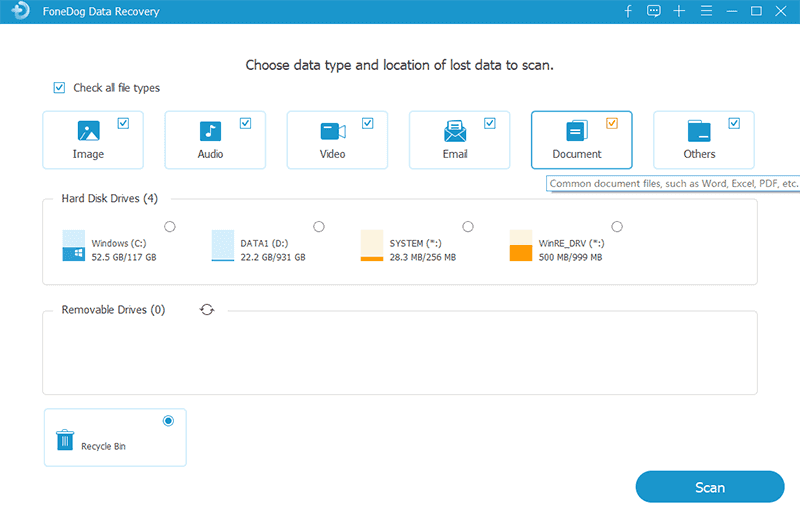By Adela D. Louie, Last updated: October 27, 2025
Lost access to crucial encrypted data? Don't panic! Dive into our detailed guide designed to rescue your invaluable files from the clutches of encryption and know more about how to recover encrypted file. This article unveils top-notch strategies and troubleshooting tips to help you reclaim those precious files, whether they've vanished due to accidental deletion, forgotten passwords, or other mishaps. Discover the secrets behind successful file recovery, learn about backup tactics, file recovery software, and expert tips to regain access to your encrypted treasures. Let's dive on!
Part 1. What's an Encrypted File?Part 2. How to Recover Encrypted FilePart 3. Troubleshooting and TipsPart 4. Best Way to Recover Encrypted File - FoneDog Data RecoveryConclusion:
Part 1. What's an Encrypted File?
An encrypted file is a file that has undergone a process called encryption, where its contents are encoded in a way that makes it unreadable to anyone who does not possess the appropriate decryption key or password. Encryption involves using algorithms to scramble the data in such a manner that only authorized individuals or systems with the decryption key can access the original information. Encryption is essential for several reasons:
- Data Security: Encrypted files provide a layer of security against unauthorized access. Even if someone gains access to the file, they cannot understand its contents without the decryption key.
- Confidentiality: It ensures that sensitive information remains confidential, especially when transmitted over networks or stored on devices. For instance, encrypted communication prevents eavesdropping or interception of sensitive data.
- Compliance: Many regulations and compliance standards (such as GDPR, HIPAA, etc.) require the protection of sensitive data through encryption to ensure privacy and prevent data breaches.
- Prevention of Unauthorized Modification: Some encryption methods also ensure the integrity of data by detecting if the encrypted files have been tampered with or modified.
- Protection Against Identity Theft: Encryption helps safeguard personal information like financial details, passwords, and other sensitive data from being stolen or misused.
- Securing Communications: Encrypted files and communications are crucial in securing sensitive conversations, emails, and other forms of digital correspondence.
Part 2. How to Recover Encrypted File
Recovering encrypted files can be challenging due to their secure nature. However, several methods and steps can potentially help you on how to recover encrypted file
- Check Backup Copies: If you've maintained backups of your encrypted files, restore them from your backup storage or system.
- File Recovery Software: Utilize reputable file recovery tools like Recuva, EaseUS Data Recovery Wizard, or Disk Drill. Follow these general steps:
- Download and install the recovery software.
- Launch the program and select the drive or location where the encrypted file was stored.
- Initiate the scan for deleted or lost files.
- Once the scan is complete, look for the encrypted file in the list of recoverable items.
- Select the file and proceed with the recovery process.
- Check Recycle Bin or Trash: Sometimes, deleted files, including encrypted ones, might still reside in the Recycle Bin (Windows) or Trash (macOS). Restore the file from there if possible.
- System Restore: If the encrypted file was lost due to recent system changes or updates, consider performing a system restore to revert your system to a previous state when the file was still accessible.
- Contact File Source or Provider: If the file was obtained or created through a service or platform, contact their support for assistance. They might have backup copies or other recovery options available.
- Remember Encryption Key or Password: Ensure you are using the correct encryption key or password. Double-check and verify the credentials to access the encrypted file.
- Professional Data Recovery Services: In extreme cases where valuable data is at stake and other methods fail, consider consulting professional data recovery services. They possess advanced tools and expertise to recover encrypted data.
- Encryption Software Support: Reach out to the support team of the encryption software used. They might offer guidance or specific recovery options tailored to their encryption methods.
Always act promptly when attempting to recover encrypted files, and refrain from writing new data to the storage device where the files were located to prevent overwriting and maximize the chances of successful recovery. Each method has its limitations, so try multiple approaches if needed to increase the likelihood of retrieving your encrypted files.
Part 3. Troubleshooting and Tips
Recovering an encrypted file can be challenging, especially if you've lost access to the decryption key or the original encryption method. Here are some troubleshooting tips and methods you can try to recover encrypted files:
- Check Backup Copies: If you've regularly backed up your encrypted files, check your backup system or storage to restore the file from a previous version.
- Use File Recovery Software: There are various file recovery tools available that can help recover deleted or lost files, including encrypted ones. Tools like Recuva, EaseUS Data Recovery Wizard, or Disk Drill might assist in recovering encrypted files.
- Check Recycle Bin or Trash: Sometimes, deleted files might still be present in the Recycle Bin (Windows) or Trash (macOS). Check these folders to see if the encrypted file is recoverable from there.
- Contact the File's Source or Provider: If the file was obtained or created through a service or platform, contact their support for assistance. Some services might have their own recovery methods or backups.
- Attempt System Restore: If the file was lost due to system changes or updates, you might try restoring your system to a previous point in time using the built-in System Restore feature (available on Windows) to recover the file.
- Professional Data Recovery Services: If the encrypted file is extremely important and none of the above methods work, consider consulting professional data recovery services. They might have advanced tools and techniques to recover encrypted data.
- Remember the Encryption Key or Password: Ensure you are using the correct encryption key or password. Sometimes, the issue might be a simple case of forgetting or mistyping the password.
- Use Encrypted File Management Software: Some file management software or encryption programs provide recovery options or have their own methods for retrieving lost encrypted files. Check the software's documentation or support resources for guidance.
- Consult with Encryption Software Support: If the file was encrypted using specific software, reach out to the support team of that software for guidance on recovering encrypted files.
Remember, successful recovery of encrypted files depends on various factors, including the encryption method used, how the file was lost, and the actions taken afterward. It's crucial to act swiftly and avoid overwriting the data on the storage medium to maximize the chances of recovery.
Part 4. Best Way to Recover Encrypted File - FoneDog Data Recovery
FoneDog Data Recovery stands out as a powerful and user-friendly tool designed to assist in the recovery of various types of files, including encrypted ones. FoneDog can help Mac users recover lost or deleted photos from various storage devices, including internal and external hard drives, SD cards, USB drives, and more. Not only camera photo files, FoneDog can also do music recovery. It is known for its high success rate and versatility, making it an excellent choice for Mac camera photo recovery.
Data Recovery
Recover deleted image, document, audio and more files.
Get deleted data back from computer (including Recycle Bin) and hard drives.
Recover loss data caused by disk accident, operation system crushes and other reasons.
Free Download
Free Download

Utilizing FoneDog Data Recovery for encrypted file recovery is simple:
- To begin the process, the initial step involves obtaining the FoneDog Data Recovery software by downloading it from the official website or an authorized source. After downloading the software, proceed to install it onto your computer system, following the screen instructions provided.
- Once the installation is complete, launch the FoneDog Data Recovery program by opening the application on your computer. Within the software interface, navigate to the section or tool specifically designed for file recovery.
- Within the file recovery tool, you will be prompted to select the type or category of files you aim to recover. In the case of encrypted files, choose this specific file type or category from the options available.
- Specify the exact storage drive or location where the encrypted file was initially stored before it was either deleted or lost. This step involves identifying and indicating the particular drive (such as C:\, D:\, etc.) or the specific folder where the encrypted file was located.
- Proceed to initiate the scanning process within FoneDog Data Recovery. This step involves triggering the software to conduct a thorough and comprehensive scan of the designated drive or location. The software will meticulously examine the selected area to identify and display a list of recoverable files, including those that are encrypted.
- Upon completion of the scanning process, the software will present a comprehensive list of identified recoverable files. Take advantage of the preview feature provided within the software to inspect and review the list of recoverable files. Locate the specific encrypted file you wish to retrieve within this list.
- Once you have located the desired encrypted file within the preview, select it to mark it for recovery. Proceed by clicking on the "Recover" button or option within the software interface to initiate the recovery process for the selected encrypted file.
- During the recovery process, the software will prompt you to designate a secure and safe location on your computer where the recovered encrypted file should be saved. Choose a different storage location than the one where the original file was located to prevent potential data overwriting and ensure the safe recovery of the file.

FoneDog Data Recovery's user-friendly interface and advanced scanning capabilities make it a reliable choice for recovering encrypted files. Its compatibility with various storage devices and file types, coupled with its efficient recovery process, positions it as a valuable tool in restoring crucial encrypted data.
Conclusion:
In conclusion, successful recovery of encrypted files involves careful steps like selecting the right recovery software, scanning the storage device, and saving the retrieved files to a secure location. Experience a hassle-free recovery process with FoneDog Data Recovery user-friendly interface and advanced capabilities. Try it now for seamless encrypted file recovery!




/
/